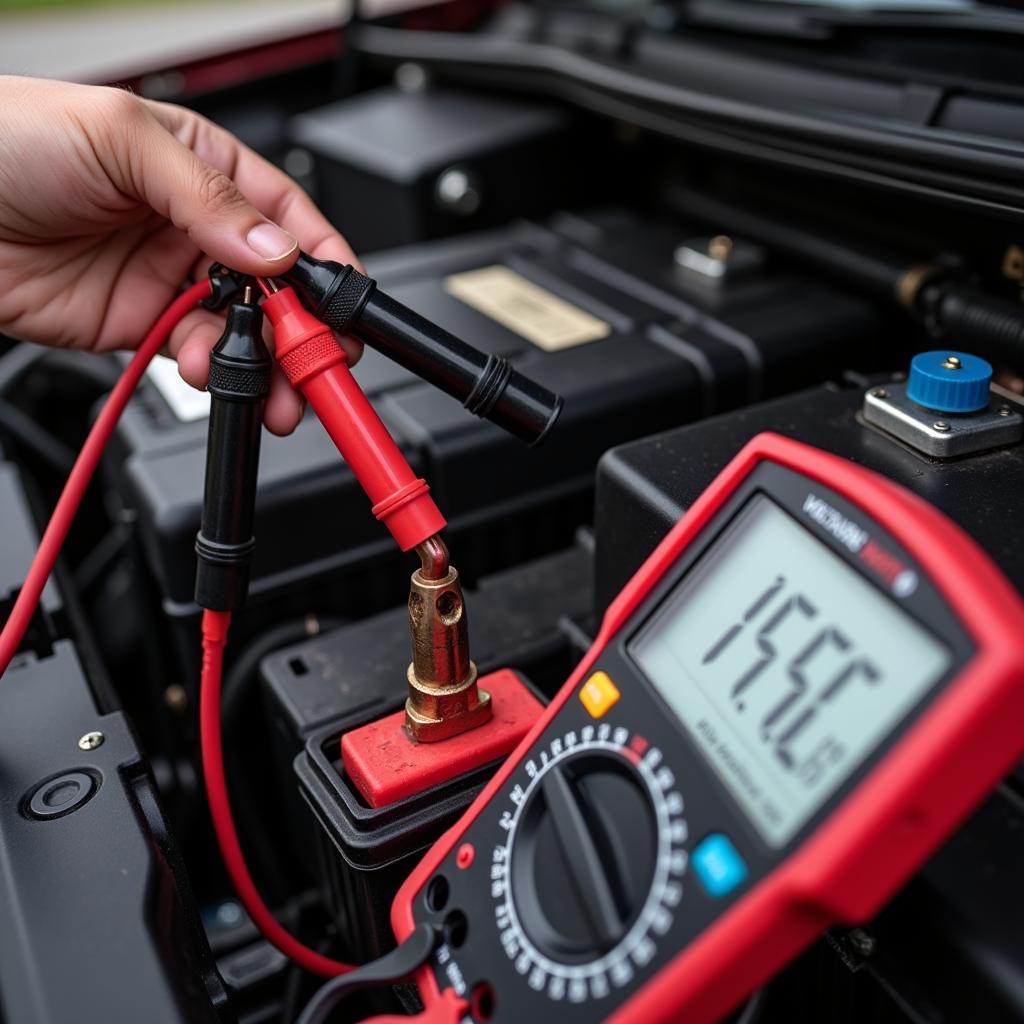A dead battery or a faulty alternator can leave you stranded. Knowing how to diagnose a faulty battery or alternator is crucial for any car owner. This guide will help you pinpoint the problem and get your car back on the road.
Identifying a Faulty Battery
Several signs point to a failing battery. These include slow engine cranking, dimming headlights, especially when accelerating, a clicking sound when turning the key, and a dashboard battery warning light. Also, check for corrosion on the battery terminals. sign of low battery in car. A simple test can be done using a multimeter to check the battery voltage. A healthy battery should read around 12.6 volts.
Testing Your Battery
Testing your battery is the first step in determining if it’s the source of your car’s electrical problems. A multimeter is the best tool for the job. Set it to DC volts and touch the positive lead to the positive battery terminal and the negative lead to the negative terminal. A reading significantly lower than 12.6 volts suggests a weak or dying battery.  Using a multimeter to test a car battery
Using a multimeter to test a car battery
Recognizing a Failing Alternator
A faulty alternator will present different symptoms. While a dead battery can cause dimming headlights, a faulty alternator will make them flicker erratically. The battery warning light might be accompanied by other warning lights, like the check engine light. You might even experience electrical accessories malfunctioning or complete electrical failure. Is something draining your battery? Find out more here: something draining my battery.
Testing Your Alternator
Testing the alternator requires a bit more effort. With the engine running, use the multimeter to measure the voltage across the battery terminals. A healthy alternator should maintain a voltage between 13.5 and 14.5 volts. A lower reading signifies a failing alternator. Remember to check your serpentine belt, as a broken belt can prevent the alternator from charging the battery. check engine battery and oil light on.
How to Jump Start a Car with a Dead Battery
If your battery is the culprit, jump-starting your car is a temporary solution. Connect the positive jumper cable to the positive terminal of the dead battery, then to the positive terminal of the good battery. Connect the negative jumper cable to the negative terminal of the good battery and then to a metal ground on the dead car. Start the good car, let it run for a few minutes, then try starting the dead car. jeep renegade dead battery.  Connecting jumper cables to a car battery
Connecting jumper cables to a car battery
“A common mistake people make when jump-starting is connecting the cables incorrectly. This can cause serious damage to both vehicles,” warns John Smith, a certified automotive electrician with over 20 years of experience.
When to Replace Your Battery or Alternator
If your battery fails the voltage test, it’s time for a replacement. Similarly, a failing alternator test indicates the need for a new one. Don’t delay these replacements, as a faulty battery or alternator can lead to more significant electrical problems down the road. “Regular maintenance and checks on your battery and alternator can save you from unexpected breakdowns,” advises Sarah Johnson, lead technician at Auto Electric Solutions. Sometimes, even with a new alternator and battery, your car still won’t start. Explore potential reasons: new alternator and battery car still wont start.
Faulty Battery or Alternator: Conclusion
Identifying a faulty battery or alternator involves recognizing the symptoms and conducting simple tests. This guide equips you with the knowledge to diagnose the issue and take appropriate action. Don’t let a faulty battery or alternator keep you stranded. Regular maintenance and prompt replacements are key to a reliable and smoothly running vehicle. “Remember, preventative maintenance is always better than dealing with a breakdown on the side of the road,” concludes Michael Davis, an automotive instructor at the National Automotive Technicians Education Foundation.
FAQ
- How long do car batteries typically last? Car batteries generally last between three to five years.
- What causes an alternator to fail? Several factors contribute to alternator failure, including worn-out bearings, damaged diodes, and excessive heat.
- Can I drive with a faulty alternator? You can drive a short distance with a faulty alternator, relying solely on the battery. However, once the battery is drained, the car will stall.
- Is it expensive to replace a battery or alternator? The cost varies depending on the make and model of your vehicle, but generally, alternators are more expensive to replace than batteries.
- How can I prevent battery and alternator problems? Regular inspections, cleaning battery terminals, and ensuring the serpentine belt is in good condition can help prevent issues.
- What are some signs of a dying battery? Slow engine cranking, dimming lights, clicking sounds when turning the key, and the battery warning light are all signs of a dying battery.
- Can a faulty alternator drain the battery? Yes, a faulty alternator won’t charge the battery properly, eventually leading to a dead battery.


